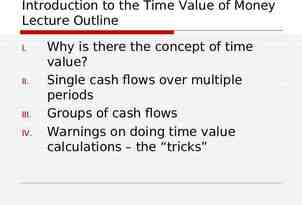Arrays in JAVA Visit for more Learning Resources
13 Slides378.00 KB
Arrays in JAVA Visit for more Learning Resources
Array is collection of related data items Creating an array Declare an array Create memory location Putting values to memory locations
Declaring an Array Variable Do not have to create an array while declaring array variable type [ ] variable name; Double[ ] myList; double myList[ ]; Both syntaxes are equivalent No memory allocation at this point
Defining an Array Define an array as follows: variable name new type [arraySize]; Number new int[5]; Mylist new int[10]; It creates an array using new dataType[arraySize]; It assigns the reference of the newly created array to the variable variable name. dataType arrayname[ ] {list of values}; Int a [ ] {1,2,3,4,5,6,7,}; Array index starts from 0 to arraySize-1; int is of 4 bytes, total space 4*10 40 bytes Declaring and defining in the same statement: Double [ ] mylist new double[10];
Creating arrays cntd.
What happens if we define diffrent type We define Int[ ] a new long[20]; incompatible types found: long[] required: int[] The right hand side defines an array, and thus the array variable should refer to the same type of array Example: int prime[100]; error ']' expected long primes[20]; The C style is not permitted in JAVA syntax long[] primes new long[20]; primes[25] 33; Runtime Error:Exception in thread “main” java.lang.ArrayIndexOutOfBoundsException
Array Size through Input . BufferedReader stdin new BufferedReader (new InputStreamReader(System.in)); String inData; int num; System.out.println("Enter a Size for Array:"); inData stdin.readLine(); num Integer.parseInt( inData ); // convert inData to int long[] primes new long[num]; System.out.println(“Array Length ” primes.length); . SAMPLE RUN: Enter a Size for Array: 4 Array Length 4
Example for array public class TestArray { public static void main(String[] args) { double[] myList {1.9, 2.9, 3.4, 3.5}; // Print all the array elements for (double element: myList) { System.out.println(element); } } } Otput: 1.9 2.9 3.4 3.5
Reusing Array Variables int[] primes new int[10]; primes new int[50]; Previous array will be discarded Cannot alter the type of array
Demonstration long[] primes new long[20]; primes[0] 2; primes[1] 3; System.out.println(primes[0]); System.out.println(primes[1]); Output: 2 3
Array Length Refer to array length using length() method A data member of array object array variable name.length for(int k 0; k primes.length;k ) Sample Code: long[ ] primes new long[20]; System.out.println(primes.length); Output: 20 If number of elements in the array are changed, JAVA will automatically change the length attribute!
Sample Program class MinArray { public static void main ( String[] args ) { int[] array { 20, 19, 1, 5, 71, 27, 19, 95 } ; int min array[0]; // initialize the current minimum for ( int index 0; index array.length; index ) if ( array[ index ] min ) min array[ index ] ; System.out.println("The minimum of this array is: " min ); } } *Program taken from: http://chortle.ccsu.edu/CS151/Notes/chap47/ch47 10.html
Two dimenssional array Representing 2D arrays Int myarray[][]; Myarray new int[3][4]; Int myarray [][] new int[3][4]; Example Int myarray[2][3] {0,0,0,1,1,1}; 2 columns and 3 rows For more detail contact us


















